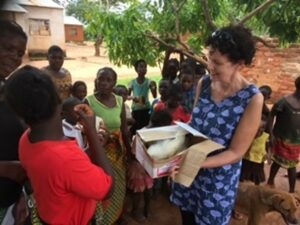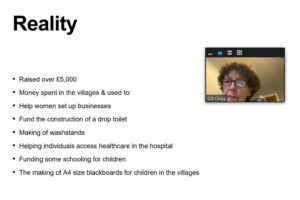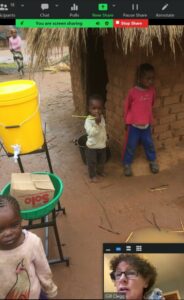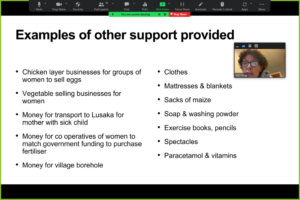 Supporting Health, Education, and Development in Rural Zambia
Supporting Health, Education, and Development in Rural Zambia
On Monday 10 June we were blown away by our guest speaker, one of our Club Members, Gill Clegg. She lived in Zambia for 6 months in 2018/19 and will be returning in October this year. Gill’s professional background is as a nurse working in paediatrics and occupational health. Please scroll down for the link to download and view her presentation.
There were 19 of us on Zoom. It is always great to be able to welcome guests from farther afield, including SI Thames Valley, Central and South West London and especially good to see Margaret from our Soroptimist Friendship Link in Chico California. It is wonderful that technology could bring us all together to hear about Gill’s journey.
Gill explained a little background on Zambia and it’s history. Katete is in the Eastern province and a rural part of Zambia with a population of 200K. Overseas doctors can go over for a minimum of 6 months.
Jon, Gill’s husband, worked in Outpatients at the local hospital. Gill’s intention was to conduct research but this wasn’t possible when she arrived.
 Gill met someone working at the hospital, Benson, and he suggested she go into the village. He was able to introduce her to villagers and assist her in helping some of the villagers. She shared photos from her trip showing the area and the environment. Gill explained that she had help from two gentlemen in the village (Benson and Samuel), who were able to act as interpreters and make introductions. They were also able to give some background and help discuss ideas.
Gill met someone working at the hospital, Benson, and he suggested she go into the village. He was able to introduce her to villagers and assist her in helping some of the villagers. She shared photos from her trip showing the area and the environment. Gill explained that she had help from two gentlemen in the village (Benson and Samuel), who were able to act as interpreters and make introductions. They were also able to give some background and help discuss ideas.
Gill shared a video of the women who broke rocks by the side of the road. She was able to purchase new tools and wheelbarrow and they celebrated with dancing and singing. They also helped get a chicken house built so they could raise the chickens to sell. The photo above is of Gill being presented with a live chicken as a thanks for the building of the chicken house.
 She shared some stories of some of the villager’s health issues, some due to vitamin deficiencies. Hygiene was also an issue so wash stands were created in the villages. The photo here in Gill’s presentation shows a water container and bowl on one of the washstands that she had had made. This helped keep the children a little healthier as skin conditions were common.
She shared some stories of some of the villager’s health issues, some due to vitamin deficiencies. Hygiene was also an issue so wash stands were created in the villages. The photo here in Gill’s presentation shows a water container and bowl on one of the washstands that she had had made. This helped keep the children a little healthier as skin conditions were common.
Two village children were living with muscular dystrophy. Through speaking to a social worker she was able to help them get wheelchairs. Two young girls living with cerebral palsy and had no furniture so furniture was built in the village so they were able sit up. Another young boy with a chronic UTI, caused by a bladder stone. He was able to get surgery and have the stone removed and he was much happier and had more energy.
A few girls were funded to attend school for a term. Education should be free but often this wasn’t the case. They paid £40 a term plus the girls brought a ream of paper, a bag of cement and a hoe.
Snakebites were a common issue in outpatients and in some cases the bites could be fatal. Gill, with the help of Samuel, was able to get some information posters made up and laminated, as well as posters about epilepsy which is also common.
They made small blackboards for learning because paper was expensive. The blackboards were cheap, made of cut wood painted black and chalk was readily available. Some of the women in the village were able to do some informal teaching for some of the village children. Toys weren’t widely available so children would make their own. Gill was able to get some footballs as the local boys were making their own from plastic bags tied up.
One of the women living in the village and she had significant mobility issues due to her being hit by a car. This had left her with one leg quite a bit shorter than the other. Gill was able to get her shoes with one built up so she could get around much easier.
 Some of the other ways Gill was able to help were shared on a slide. Items such as exercise books, pencils, spectacles, vitamins, clothes. They supported the village to build boreholes. Money and transport to Lusaka for a mother with sick child. Money to support cooperatives of women to match government funding to purchase fertiliser.
Some of the other ways Gill was able to help were shared on a slide. Items such as exercise books, pencils, spectacles, vitamins, clothes. They supported the village to build boreholes. Money and transport to Lusaka for a mother with sick child. Money to support cooperatives of women to match government funding to purchase fertiliser.
Gill and her husband are going back in October for a short visit this time. She has funds and contacts such as Benson. She hopes to be able fund more girls into education and see how the businesses are going.
As always Soroptimists asked some great questions – see Q & A below.
Q Did you see any FGM while there.
A Gill said the hospital said circumcision was only carried out on boys to reduce the likelihood of HIV infection. The hospital were very definite that this was not part of their belief system. Zambia is approx 95% Christian & as far as she knows it wasn’t a practice in the Eastern Province so will find out when she returns in October.
Q What are the main health issues she encountered
A Gill said Type 2 diabetes was common. High blood pressure and strokes were also common. There was HIV too.
A common health problem seen in the hospital was heart failure – due to rheumatic fever – arising from a strep throat infection. One of the outcomes can be damage to the heart valves, resulting in the heart having to work harder & enlarging. Children & young adults were seen with this. What they needed was valve replacement surgery, which wasn’t available so they generally died in teens or early twenties. Antibiotics would have prevented this & it was something that was seen in the UK before they were discovered.
Q Was it surprising how prevalent traditional healing was?
A It was a poor province and traditional healing methods were common. Traditional healers carried a lot of power so they didn’t get challenged and many times the traditional healers methods can make issues worse and sometimes result in death. Common ‘cures’ were ‘herbal medicine’ – plants & bark material & tattoos eg cuts to the body & plant matter rubbed in.
Q How did Gill adjust on returning home
A It did take time to readjust. The life of the villagers and their experiences were very humbling and she felt emotional comparing the different lifestyles.
Q How long did it take to gain the trust of the villagers?
A Gills experience was that people didn’t ask questions and they welcomed the assistance. There was no negativity or resentment from any of the people she met.
There were lots of positive comments with praise for Gill in the Zoom chat: “it is heart-warming to see their excitement.” “We love the little man in the Union Jack T shirt!!!” “That much joy over a wheelbarrow is humbling”. “Thanks . A really interesting talk looking forward to hearing about what has happened when you get back.” “Fascinating insight into situation in Zambia”. “Thanks, lovely to be here, blown away by Gills talk.”
Jane thanked Gill and said we had all been stunned by how much Gill achieved, making a difference to many people’s lives in a very short time! It will be really interesting to hear from Gill again when she returns in November, to find out what’s happened since they were there. Gill was keen to let us know that she isn’t telling her story to ask for money, but you can see that any money donated will be spent wisely.
Please click here to download Gill’s presentation as a PDF file – the original included videos of people dancing with great excitement and joy from everything Gill did for the community – it includes lots of photos but sadly the videos won’t transfer: Katete Zambia Presentation

